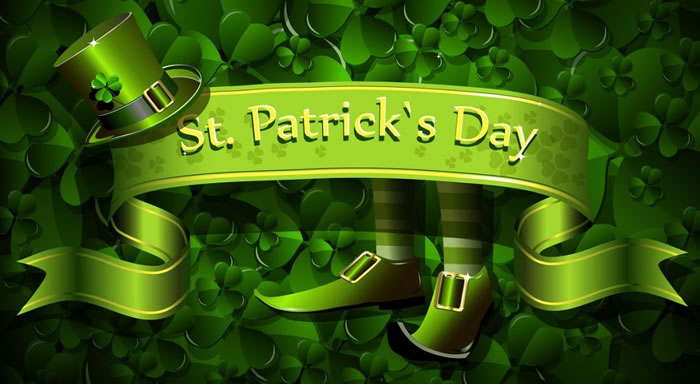Holiday
Happy St. Patrick’s Day: 5 Facts Bet You Didn’t Know

1. Who Is St. Patrick?
Saint Patrick, who was born in what is now modern-day Northern Ireland but lived during the fifth century, is widely recognized as Ireland’s patron saint and its national apostle. Although he was born in Roman Britain, he was kidnapped and sold into slavery in Ireland when he was 16 years old. Later, he was able to get away, but he eventually went back to Ireland, where he is credited with spreading Christianity to the locals there.
It is believed that St. Patrick died on March 17, 461; yet, throughout the centuries that followed, the mythology that surrounded his life grew increasingly more engrained in Irish culture: The story that St. Patrick used the three leaves of a local Irish clover called the shamrock to explain the Holy Trinity (Father, Son, and Holy Spirit) is one of the most famous legends about the saint.
2. When Was St. Patrick’s Day First Celebrated?
The celebration of the Roman Catholic feast day of Saint Patrick on March 17 has been a tradition among Irish people at least as far back as the ninth or tenth century. It wasn’t in Ireland, but rather the United States that played host to the very first St. Patrick’s Day parade. According to the records, a procession celebrating Saint Patrick’s Day was held on March 17, 1601, in a Spanish colony that is today the city of St. Augustine in Florida. Ricardo Artur, an Irish vicar as in Spanish Colony, was responsible for coordinating both the march and a St. Patrick’s Day event that supposedly occurred a year earlier.
On March 17, 1772, homesick Irish troops serving in the English military marched through New York City to honor Saint Patrick, the patron saint of Ireland. This event took place more than a century later. From that point on, people’s excitement for the St. Patrick’s Day parades held in New York City, Boston, and other early American cities only grew better.
3. Growth of St. Patrick’s Day Celebrations
The subsequent 35 years saw a growth in Irish nationalism among immigrants to the United States, which led to the formation of organizations that dubbed themselves “Irish Aid” groups such as the Friendly Sons of Saint Patrick and the Hibernian Society. The bagpipes and drums would be prominent in each organization’s yearly parades. The bagpipes gained their popularity grew in the military of Scotland and the United Kingdom.
In the year 1848, a number of New York Irish Aid groups reached the conclusion that they should combine their several St. Patrick’s Day parades to create a single official procession for the city of New York. Over 150,000 people take part in this march every year, making it the largest and oldest civilian procession in the United States as well as the oldest in the world.
Nearly three million people gather along the parade route each year to watch the event, which lasts for more than five hours and covers a distance of 1.5 miles. Parades honoring the holiday are held in Boston, Chicago, Philadelphia, and Savannah as well. Participation in each of these parades ranges from 10,000 to 20,000 people. As a direct consequence of the COVID-19 pandemic, the New York Municipal parade was one of the first significant city events to be called off in the year 2020; it was also called off the next year, 2021. In 2022, the parade returned to New York City as well as to other cities around the country.
Find the perfect St. Patrick’s Day present here! Let me provide some advice!

BUY NOW
St.Patricks Day Gnome T-Shirt

4. A History of Irish Americans
Before the middle of the 19th century, the majority of Irish people who settled in the United States were members of the Protestant middle class. When the Great Potato Famine struck Ireland in 1845, close to one million impoverished and illiterate Irish Catholics immediately started migrating to the United States in an attempt to avoid hunger.
Immigrants in the United States had a difficult time obtaining work of any kind since the majority of Americans adhered to the Protestant religion and despised the immigrants’ exotic religious beliefs and unusual dialects. When Irish Americans in the nation’s cities went out into the streets on St. Patrick’s Day to celebrate their history, cartoons published in the country’s newspapers showed them as drunk, angry monkeys.
The Irish Americans came to the conclusion fairly quickly, however, that their enormous and continuously increasing population gave them a political power that had not yet been fully utilized by them. They began to organize, and their voting bloc, which became known as the “green machine,” became a significant swing vote for political candidates. All of a sudden, the annual St. Patrick’s Day parades became not just a powerful symbol for Irish Americans, but also an event that a wide variety of political candidates felt obliged to attend.
A great moment for the many Irish Americans whose ancestors had to combat preconceptions and racial discrimination to win acceptance in the New World was when President Harry S. Truman attended the St. Patrick’s Day parade in New York City in 1948. The event was held on March 17th.
5. Festivals Honoring St. Patrick’s Day in Different Parts Of The World
Today, people of many various ethnicities and cultural origins gather to celebrate Saint Patrick’s Day, particularly in the United States, Canada, and Australia. St. Patrick’s Day is celebrated all over the world, even in countries that are quite far away from Ireland, such as Japan, Singapore, and Russia. The largest productions are held in North America, but the holiday is observed all around the world. Irish soda bread, corned beef and cabbage, and champ are three dishes that are often prepared for Saint Patrick’s Day. On St. Patrick’s Day, many individuals in the United States dress in green to demonstrate their support for the Irish culture.
The celebration of Saint Patrick’s Day in modern-day Ireland has historically been observed as a religious holiday. In point of fact, Irish regulations required that pubs be shut down on the 17th of March literally up to the 1970s. However, beginning in 1995, the Irish government launched a nationwide campaign with the goal of utilizing interest in St. Patrick’s Day to drive tourism and showcase Ireland and Irish culture to the rest of the world. This campaign is still ongoing.
Conclusion
The Leprechaun is a symbol that is generally linked with the Irish celebration. The appellation “lobaircin,” which literally translates to “small-bodied person,” was given to these legendary characters in Irish tradition. The idea in leprechauns almost likely originates from the Celtic belief in fairies, which are described as being like little men and women who wield magical abilities either to good or evil. According to traditional Celtic folklore, leprechauns were grumpy creatures that were tasked with repairing the footwear of their fellow fairies.
Even though they were just minor characters in Celtic tradition, leprechauns were famous for their cunning, which they frequently employed in order to safeguard the legendary riches they guarded. On May 13, leprechauns are honored with their own celebration, but they are also recognized on St. Patrick’s Day, while many people dress up as the crafty fairies.
Find the perfect Saint Patrick’s Day apparel here! There are a lot of suggestion for you, check out at Happyinktee.

